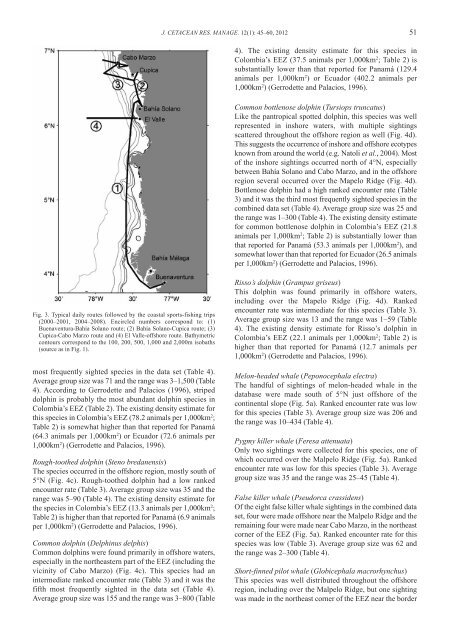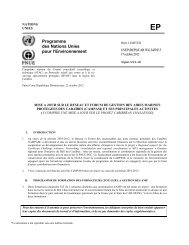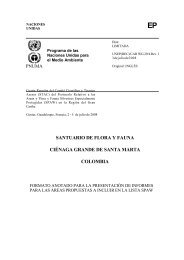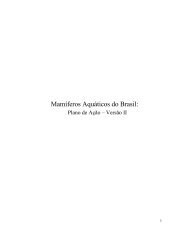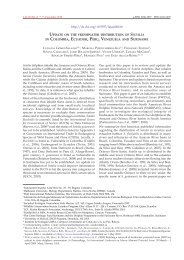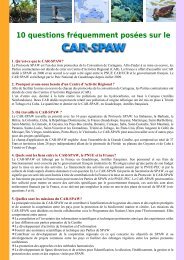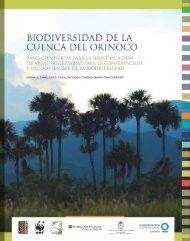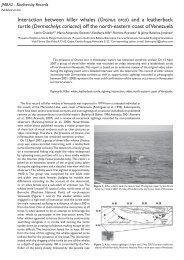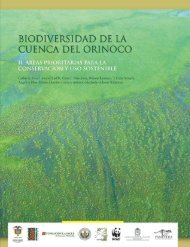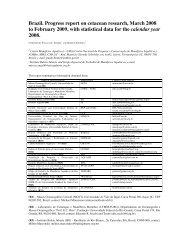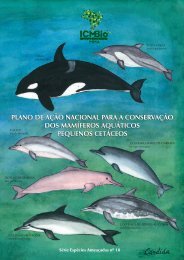Daniel M. Palacios et al. 2012. Cetacean distribution and relative ...
Daniel M. Palacios et al. 2012. Cetacean distribution and relative ...
Daniel M. Palacios et al. 2012. Cetacean distribution and relative ...
- No tags were found...
Create successful ePaper yourself
Turn your PDF publications into a flip-book with our unique Google optimized e-Paper software.
J. CETACEAN RES. MANAGE. 12(1): 45–60, 2012 514). The existing density estimate for this species inColombia’s EEZ (37.5 anim<strong>al</strong>s per 1,000km 2 ; Table 2) issubstanti<strong>al</strong>ly lower than that reported for Panamá (129.4anim<strong>al</strong>s per 1,000km 2 ) or Ecuador (402.2 anim<strong>al</strong>s per1,000km 2 ) (Gerrod<strong>et</strong>te <strong>and</strong> <strong>P<strong>al</strong>acios</strong>, 1996).Common bottlenose dolphin (Tursiops truncatus)Like the pantropic<strong>al</strong> spotted dolphin, this species was wellrepresented in inshore waters, with multiple sightingsscattered throughout the offshore region as well (Fig. 4d).This suggests the occurrence of inshore <strong>and</strong> offshore ecotypesknown from around the world (e.g. Natoli <strong>et</strong> <strong>al</strong>., 2004). Mostof the inshore sightings occurred north of 4°N, especi<strong>al</strong>lyb<strong>et</strong>ween Bahía Solano <strong>and</strong> Cabo Marzo, <strong>and</strong> in the offshoreregion sever<strong>al</strong> occurred over the Mapelo Ridge (Fig. 4d).Bottlenose dolphin had a high ranked encounter rate (Table3) <strong>and</strong> it was the third most frequently sighted species in thecombined data s<strong>et</strong> (Table 4). Average group size was 25 <strong>and</strong>the range was 1–300 (Table 4). The existing density estimatefor common bottlenose dolphin in Colombia’s EEZ (21.8anim<strong>al</strong>s per 1,000km 2 ; Table 2) is substanti<strong>al</strong>ly lower thanthat reported for Panamá (53.3 anim<strong>al</strong>s per 1,000km 2 ), <strong>and</strong>somewhat lower than that reported for Ecuador (26.5 anim<strong>al</strong>sper 1,000km 2 ) (Gerrod<strong>et</strong>te <strong>and</strong> <strong>P<strong>al</strong>acios</strong>, 1996).Fig. 3. Typic<strong>al</strong> daily routes followed by the coast<strong>al</strong> sports-fishing trips(2000–2001, 2004–2008). Encircled numbers correspond to: (1)Buenaventura-Bahía Solano route; (2) Bahía Solano-Cupica route; (3)Cupica-Cabo Marzo route <strong>and</strong> (4) El V<strong>al</strong>le-offshore route. Bathym<strong>et</strong>riccontours correspond to the 100, 200, 500, 1,000 <strong>and</strong> 2,000m isobaths(source as in Fig. 1).most frequently sighted species in the data s<strong>et</strong> (Table 4).Average group size was 71 <strong>and</strong> the range was 3–1,500 (Table4). According to Gerrod<strong>et</strong>te <strong>and</strong> <strong>P<strong>al</strong>acios</strong> (1996), stripeddolphin is probably the most abundant dolphin species inColombia’s EEZ (Table 2). The existing density estimate forthis species in Colombia’s EEZ (78.2 anim<strong>al</strong>s per 1,000km 2 ;Table 2) is somewhat higher than that reported for Panamá(64.3 anim<strong>al</strong>s per 1,000km 2 ) or Ecuador (72.6 anim<strong>al</strong>s per1,000km 2 ) (Gerrod<strong>et</strong>te <strong>and</strong> <strong>P<strong>al</strong>acios</strong>, 1996).Rough-toothed dolphin (Steno bredanensis)The species occurred in the offshore region, mostly south of5°N (Fig. 4c). Rough-toothed dolphin had a low rankedencounter rate (Table 3). Average group size was 35 <strong>and</strong> therange was 5–90 (Table 4). The existing density estimate forthe species in Colombia’s EEZ (13.3 anim<strong>al</strong>s per 1,000km 2 ;Table 2) is higher than that reported for Panamá (6.9 anim<strong>al</strong>sper 1,000km 2 ) (Gerrod<strong>et</strong>te <strong>and</strong> <strong>P<strong>al</strong>acios</strong>, 1996).Common dolphin (Delphinus delphis)Common dolphins were found primarily in offshore waters,especi<strong>al</strong>ly in the northeastern part of the EEZ (including thevicinity of Cabo Marzo) (Fig. 4c). This species had anintermediate ranked encounter rate (Table 3) <strong>and</strong> it was thefifth most frequently sighted in the data s<strong>et</strong> (Table 4).Average group size was 155 <strong>and</strong> the range was 3–800 (TableRisso’s dolphin (Grampus griseus)This dolphin was found primarily in offshore waters,including over the Mapelo Ridge (Fig. 4d). Rankedencounter rate was intermediate for this species (Table 3).Average group size was 13 <strong>and</strong> the range was 1–59 (Table4). The existing density estimate for Risso’s dolphin inColombia’s EEZ (22.1 anim<strong>al</strong>s per 1,000km 2 ; Table 2) ishigher than that reported for Panamá (12.7 anim<strong>al</strong>s per1,000km 2 ) (Gerrod<strong>et</strong>te <strong>and</strong> <strong>P<strong>al</strong>acios</strong>, 1996).Melon-headed wh<strong>al</strong>e (Peponoceph<strong>al</strong>a electra)The h<strong>and</strong>ful of sightings of melon-headed wh<strong>al</strong>e in thedatabase were made south of 5°N just offshore of thecontinent<strong>al</strong> slope (Fig. 5a). Ranked encounter rate was lowfor this species (Table 3). Average group size was 206 <strong>and</strong>the range was 10–434 (Table 4).Pygmy killer wh<strong>al</strong>e (Feresa attenuata)Only two sightings were collected for this species, one ofwhich occurred over the M<strong>al</strong>pelo Ridge (Fig. 5a). Rankedencounter rate was low for this species (Table 3). Averagegroup size was 35 <strong>and</strong> the range was 25–45 (Table 4).F<strong>al</strong>se killer wh<strong>al</strong>e (Pseudorca crassidens)Of the eight f<strong>al</strong>se killer wh<strong>al</strong>e sightings in the combined datas<strong>et</strong>, four were made offshore near the M<strong>al</strong>pelo Ridge <strong>and</strong> theremaining four were made near Cabo Marzo, in the northeastcorner of the EEZ (Fig. 5a). Ranked encounter rate for thisspecies was low (Table 3). Average group size was 62 <strong>and</strong>the range was 2–300 (Table 4).Short-finned pilot wh<strong>al</strong>e (Globiceph<strong>al</strong>a macrorhynchus)This species was well distributed throughout the offshoreregion, including over the M<strong>al</strong>pelo Ridge, but one sightingwas made in the northeast corner of the EEZ near the border


